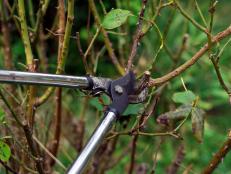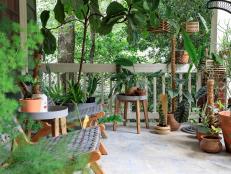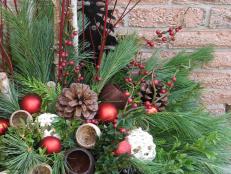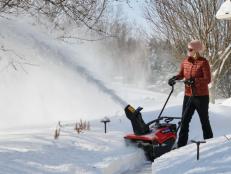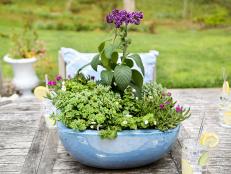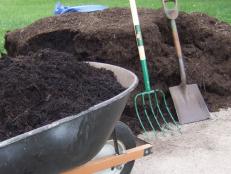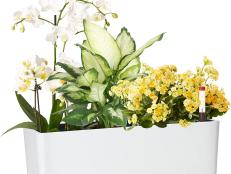The Cold, Hard Facts on Protecting Potted Plants

Shutterstock/Tisha Razumovsky
Winter container gardening is tough — you have to protect plants from wind, harsh sunlight and drying out. The biggest challenge, though, is guarding against root damage caused by rapidly fluctuating temperatures.
Even plants that are hardy to your zone can be hit hard when planted in a container in the winter. Although the top part of a plant has the ability to go dormant, the roots don't.
"Essentially any type of container exposes the roots to ambient temperatures," says Dr. Hannah Mathers, assistant professor in nursery and landscape extension at Ohio State University in Columbus. Mature roots can gradually get used to the cold, but young, immature roots can't. In containers, young roots grow on the outer part of the rootball. When exposed to the cold, young roots are unable to acclimate and die back.
And, young or old, the roots are usually not has hardy as the plant's top. American holly (Ilex opaca) is hardy to USDA Zone 5. The top part (stems and foliage) of the plant will survive to a temperature of about -20 F, but immature roots die at 23 degrees above zero, and mature roots at nine degrees. In the ground and insulated by the earth, that's usually no problem for the roots of hollies in Zone 5 where the average minimum temperature is -10 to -20 F. But in a container, root damage in American holly would begin to occur at 23 degrees if left unprotected — a drastic difference from -20 degrees.
To protect delicate root systems, consider these tips from the experts:
- Avoid exposing plants to the freeze/thaw cycle. Rapidly fluctuating temperatures (from cold to hot and back) can cause significant injury to roots and, as a result, may even heave the plant out of the pot. To avoid this, place pots on soil instead of pavement. For plants in the ground, the main source of heat for roots is the heat of the earth. For containers on pavement, the sun can warm the pavement considerably, elevating the temperature of the rootball. This is followed by a drop in temperatures at night. The fluctuation exposes containers on pavement to freezing and thawing.
- When choosing a pot, bigger is better. "The larger the volume of the container, the better off the plant will be," Hannah says. The soil in a 15-gallon container will insulate the roots better than that in a one-gallon pot. The smaller container will freeze faster. A good rule of thumb: select a larger-sized pot that also has a thickness of one inch or more. Also, smaller pots dry out more quickly than large pots.
- Plant the container as early as possible in order to allow plants to harden off. If plants are healthy and go into winter with mature roots, they have a much better chance to harden off and, as a result, will tolerate winter stress much better. One trick: Select container plants that are hardy to two zones cooler than your hardiness zone.
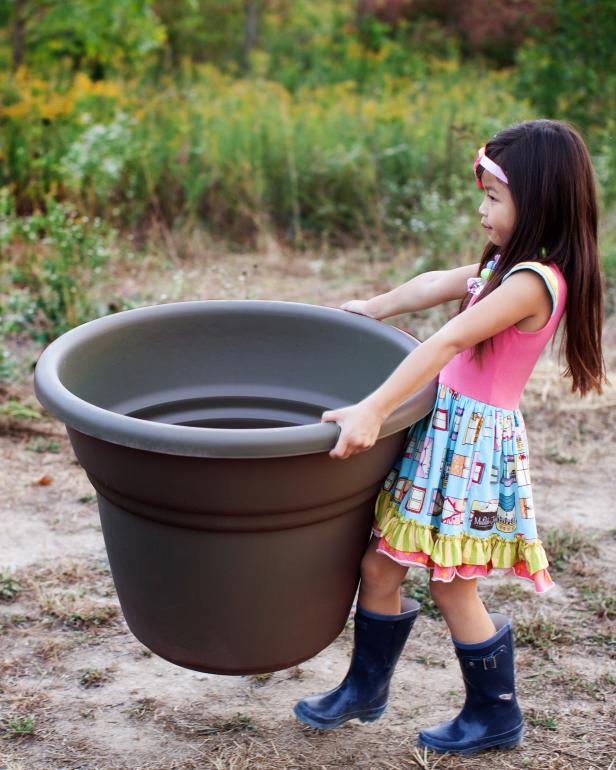
Image courtesy of Bloem
Choosing the Right Pot
Your climate determines which types of pots will do best in winter. Untreated porous containers, such as terra cotta and ceramic, tend to crack and break with freezing and thawing. In his USDA Zone 4 garden, Ray Mims, director of horticulture at the Denver Botanic Gardens, likes the look of his large terra-cotta pots and wants to use them all year long. So he treats the interior of his pots with pool paint. The coat of pool paint helps to prevent moisture from entering the porous surface and causing cracks from freezing and thawing.
Wood containers can be very durable, depending on wood type and exposure to the elements. Non-porous containers, like concrete, plastic and metal containers, are great for their ability to withstand the elements. However, concrete and metal containers can be heavy and awkward to move once set in place. Plastic pots have the potential to crack over a period of time. Foam or resin pots come in a variety of looks and can be a lightweight alternative to concrete and metal. When using lightweight plastic, foam or resin pots, top-heavy plants can topple over when hit with strong wind, so be careful to avoid causing winter injury to plants.
Be wary of using thin-walled pots and hanging baskets. The insulation in these containers may not be enough to protect the root zone. Plus, hanging baskets tend to dry out faster than their ground-level counterparts.
If possible, avoid using saucers; collected water can freeze. Raise your pots on feet to provide good drainage.
Find the Right Place
A pot's location also determines how well plants are protected. Place containers on the north or east sides of the house where conditions are typically shadier. Southern exposures tend to have the greatest temperature swing.
Hardy dwarf conifers, evergreens, ornamental grasses and trees or shrubs with interesting habits or bark colors are great for adding winter interest. If possible, place pots with these plants near a window or front door where they'll be easily seen.
How to Water During the Winter
Because there's typically less rainfall in winter, adequately water your pots. Broadleaf and needled evergreens are particularly sensitive to desiccation. The ideal time to water is during the day when temperatures have warmed above freezing. If the forecast predicts windy or freezing conditions, try to water before these conditions occur.
"When water freezes, it gives off heat. There's a latent heat release," Hannah says. Water provides some warmth to the root zone. Frost penetrates deeper into the air spaces of dry soil than moist soil because, in moist soil, water has filled the air pockets. Hannah suggests that even if temperatures are at freezing and the pot is dry, it's important to water because it will help to better protect the plants' roots.
"When plants aren't properly overwintered, they'll have problems come spring," she says. For example, a plant may not break out of dormancy or it will have delayed bud break. Or, it may begin new growth at the start of the growing season, but if the roots can't support this growth, the plant dies. Even if container plants are able to make it through winter, they may have slowed growth, developing very little by following fall.
Overwintering Outdoors
Depending on where you live, it may be necessary to provide added protection for your pots. Here are several options for overwintering containers:
- Group several pots together on soil and close to the house or wall. Place the cold-hardiest plants on the outskirts of the grouping with the less hardy plants in the center. Put straw bales on the periphery. Putting them together increases the mass and volume of insulation and protects them from cold, harsh winds that cause desiccation and freezing.
- For added insulation, mulch pots with straw, mulch or shredded leaves. Snow also acts as a good insulator. An interesting idea for insulating containers would be group pots together in a preformed pond liner and fill the liner with mulch.
- Because a majority of roots tend to be on the outside of the rootball, the only insulation for roots is the wall of the pot itself. Prior to planting, insert foam at least one inch thick around the walls of square pots to insulate roots. For rounded pots, line the container's interior walls with foam peanuts.
- Bury pots in soil to the top of the container.
- Remove the rootball from the container and plant in the ground. Clean the container and store indoors. Dig up the root ball next season and repot into the same or a larger container.
- Wrap pots in burlap, bubble wrap, old blankets or geotextile blankets. It isn't necessary to wrap the entire plant because it's the roots that need shielding. These protective coverings will help to trap heat and keep it at the root zone.
- If low temperatures loom, cover plants with cloth, burlap or plastic at night. If you use plastic, be sure to remove the covering during the day since temperatures can heat up, causing premature bud growth. Also, when covering, avoid damaging the top part of the plants. Injury sets up the plant for cold and pest damage.
- Insert your pot into a larger pot for added protection. This will work best if the larger pot has thick walls or added insulation.
For USDA Zones 7 through 11, hard freezes may be infrequent to nonexistent, so adding insulation or bringing pots in for the winter may not be necessary. However, there are some chores that you should still be aware of. Due to cooler temperatures in the winter, plant growth will slow and watering may become infrequent. However, salt can build up in the soil, raising levels to toxicity. Water well to leach out the salts. Also, fertilize plants as needed.






